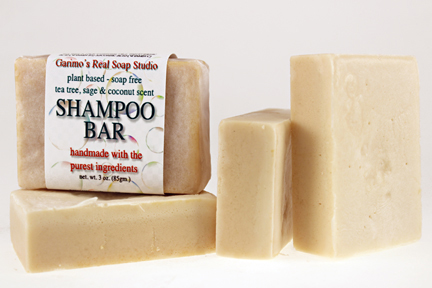
|
|
Garimo's Shampoo Bars Plant based, Soap free, without the plastic bottles and water. one bar is the equivalent of 2-3 bottles of liquid shampoo
|
|
The shampoo bars are not soap and are heated ingredients rather than being saponified with lye like bar soap. After weighing the ingredients, I slowly heat & stir until everything is a melted hot goo. Then I ladle it into the molds, cool until solid and then remove from the molds. Without the alkalinity of the lye, these bars are acidic, which make them better for our hair. Soaps that have a higher alkaline PH cause the cuticles of our hair to open like a pinecone and acidic products like apple cider vinegar closes the cuticles, which tends to make for easier detangling. Also saponified oil soaps leave hair feeling like they have a film or something left behind. After reading many ingredient lists of popular shampoo bars, I selected these common ingredients. Because in addition to wanting to make a natural soap product, I wanted one that does a good job even if I had to use something not organic. I also wanted ingredients that were created without solvent residues like Sodium lauryl sulfate that seems to be the main ingredient in the most commercial bar shampoos. So below is an explanation of ingredients I have settled on for now
Ingredients:
|

|
|
SODIUM COCOYL ISETHIONATE Commonly known as Baby Foam due to its exceptional mildness, Sodium Cocoyl Isethionate Raw Material is a surfactant that is comprised of a type of sulphonic acid called Isethionic Acid as well as the fatty acid - or sodium salt ester - obtained from Coconut Oil. It is a traditional substitute for sodium salts that are derived from animals, namely sheep and cattle. Sodium Cocoyl Isethionate exhibits high foaming ability, producing a stable, rich and velvety lather that does not dehydrate the skin, making it ideal for addition to water-free products as well as skin care, hair care, and bath products. This high-performance surfactant, which is equally effective in both hard and soft water, is a popular choice for addition to liquid shampoos and bar shampoos, liquid soaps and bar soaps, bath butters and bath bombs, and to shower gels, to name a few foaming products. This lightly-scented and conditioning cleansing agent is gentle enough for use on the delicate skin of babies, making it an ideal surfactant for makeup as well as personal care products and natural toiletries. Its emulsifying property, which allows water and oil to mix, makes it a popular ingredient in soaps and shampoos, as it encourages dirt to attach itself to them, which in turn makes it easier for it to be washed away. Its deluxe foaming capacity and conditioning effects leave the hair and skin feeling hydrated, soft, and silky-smooth.
CREAMED COCONUT,
All natural plant derived Decyl Glucoside is a premium non ionic surfactant derived from natural and renewable feedstock. It is used for formulating many quality products like liquid soaps, shampoos , body washes, and high quality institutional cleansers. Sodium Coco Sulfate is a surfactant. All surfactants are partly water-soluble and partly oil-soluble, allowing oil and water to become dispersed. Above a minimum concentration, the surfactant molecules become organized in a structure that can trap the oil-based dirt from the hair, allowing it to be rinsed away. Want to know the difference between SLS & SCS? Read on...
There is a lot of confusing information going around the internet about the similarities/differences between Sodium lauryl sulfate (SLS) and Sodium coco sulfate (SCS) in particular.
Stearic Acid
Behentrimonium Methosulfate (and) Cetearyl Alcohol Gentle and effective, BTMS helps hair retain a springy bounce and volume, while leaving it feeling silky smooth. It is also very effective for use in skin and body care products, especially when a light, powdery soft, non-greasy feel and finish is desired. BTMS is free from ethoxylated ingredients.
Organic Aloe Vera Oil
Pure Steamed Essential oils Panthenol acts as a lubricant on the skin surface, which gives the skin a soft and smooth appearance. Panthenol and Pantothenic Acid also enhance the appearance and feel of hair, by increasing hair body, suppleness, or sheen, or by improving the texture of hair that has been damaged physically or by chemical treatment. Panthenol and Pantothenic Acid (vitamin B5) have the same biological activity and Panthenol can be converted (by oxidation) to vitamin B5 in the skin. Pantothenic Acid is found in all living cells and tissues and is essential for normal metabolism and hormone production. Ascorbic Acid is commonly known as Vitamin C. Salts of Ascorbic Acid. These ingredients are used in a variety of cosmetics and personal care products including makeup, as well as skin and hair care products. Ascorbic Acid and its salts are used in the formulation of personal care products as antioxidants to slow deterioration caused by exposure to the air and also to control the ph of the finished product. Ascorbic Acid is an essential nutrient required for collagen production, tissue repair, and for the synthesis of neurotransmitters. It also acts as an antioxidant, plays a role in resistance to infections, and is used for the treatment and prevention of scurvy.
Titanium Dioxide is a naturally-occurring mineral found in the earth's crust. |
 Return to Garimo's Real Soap Studio |